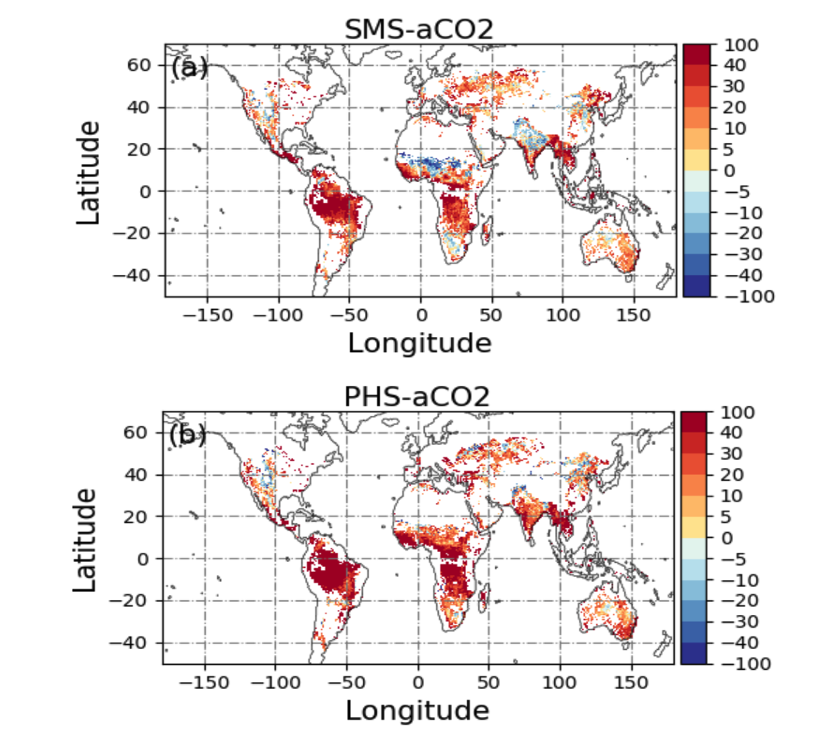Understanding How Plants Respond to Coexisting Soil and Air Dryness in Global Simulations
Soil water stress has a stronger influence than vapor pressure deficit on limiting canopy conductance in coupled land-atmosphere simulations.
The Science
The vapor pressure deficit (VPD), the difference between the amount of moisture in the air and how much moisture the saturated air can hold, has risen over recent decades and is projected to further increase in the future with global warming. While numerous studies have highlighted ecosystem sensitivities to soil water availability, it is critically important to understand how plant physiology responds to VPD. The scientists used the Energy Exascale Earth System Model (E3SM) and statistical analysis to study the simulated daily canopy conductance (Gc), how easily water can transfer from plants to the atmosphere, and its dependence on soil water and VPD. The results show that soil water stress has a stronger influence on Gc, a key variable in controlling the exchange of water vapor and carbon dioxide (CO2) between plants and the atmosphere, than VPD in the growing season.
The Impact
E3SM simulations show that soil water stress limits Gc more than VPD does, except in grasslands. Plant hydraulics processes further accentuate the role of soil water stress in limiting Gc by increasing soil wetness and evapotranspiration, leading to lower VPD. This study also showed that elevated CO2 reduces Gc by increasing plant water use efficiency, mitigating soil water stress on Gc. The combined E3SM and statistical analysis framework introduced here is particularly useful for evaluating and improving model performance against experimental data by identifying which drivers Gc is most sensitive to. The method may also be practical for studying future plant response to extreme environmental conditions when increasing CO2 levels affect Gc.

Figure 1. Soil water dominance (positive values, yellow to red) in limiting Gc is much more extensive than VPD dominance (negative values, blue colors) under dry soil water conditions. VPD dominated regions are mainly located in cropland near India and grassland in the Sahel for soil moisture representation of plant response to water stress. More areas in the northern hemisphere experience soil water stress if the model represents plant water stress response mechanistically (bottom) compared to empirical representation (top). Soil moisture stress (SMS) is plotted in the top panel and plant hydraulics scheme (PHS) in the bottom, both for the simulation performed under historical levels of CO2 (denoted with “aCO2”).
Summary
Plants close the pores on their leaves in a process known as stomatal closure to prevent water loss, as excessive water loss can harm or kill them. It is unclear whether air or soil dryness plays a larger role when plants close their pores, especially when both conditions are present. As air and soil dryness may change differently in different regions under global warming, understanding their relative influence on stomatal closure is important for understanding plant response to rising temperatures and CO2 levels. The scientists applied a simple model to identify how much each kind of dryness contributes to stomatal closure as simulated by an Earth system model. The results (Fig 1.) showed a high probability that soil dryness dominates stomatal closure when both soil and air dryness are present during both present-day conditions and hypothetical future conditions with quadrupled CO2 concentrations. The team also found that including plant hydraulics, both water movement in the soil and water transport within the plant, in E3SM can increase the relative influence of soil dryness on stomatal closure because the plant physiological response reduces air dryness.
Publication
- Fang, Yilin, and L. Ruby Leung. 2022. “Relative Controls Of Vapor Pressure Deficit And Soil Water Stress On Canopy Conductance In Global Simulations By An Earth System Model”. Earth’s Future 10 (9). American Geophysical Union (AGU). doi:10.1029/2022ef002810.
Funding
- The Department of Energy Office of Science, Biological and Environmental Research program supported this study as part of the Earth System Model Development program area through the E3SM project.
Contact
- L. Ruby Leung, Pacific Northwest National Laboratory
This article is a part of the E3SM “Floating Points” Newsletter, to read the full Newsletter check:



